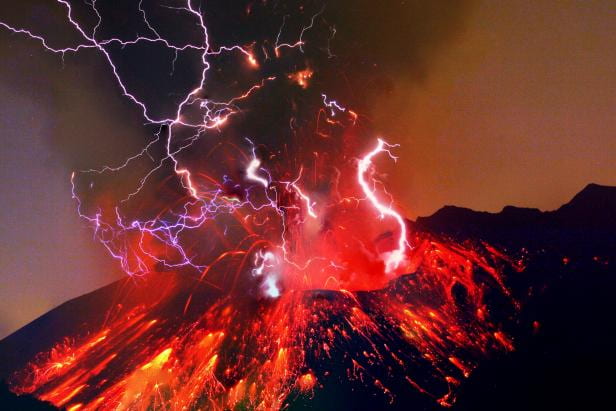How do volcanoes make lightning?
When hot, molten rock rises through the Earth’s crust and exits through to the surface, it often results in a volcanic eruption. These eruptions expel a large amount of ash, dust, rock, volatile gases, and lava relatively quickly. While we might think of these as the major features of a volcano, there’s often a magnificent visual sight that accompanies them: volcanic lightning. Even though every volcanic eruption will not be followed by a spectacular light show, it’s been observed many times.
Volcanic lightning is a phenomenon that typically occurs at the initial stages of a volcanic eruption. Many scientists are puzzled by its exact cause. It can either happen close to the ground in dense ash clouds or high up near the stratosphere in the plume (a cylinder-shaped column) of volcanic smoke. For volcanic lightning that occurs near the surface, studies have attributed the cause to the friction produced by the rubbing of individual ash particles, generating sufficient static electricity to create a lightning bolt. On the other hand, sky-high volcanic lightning has a more interesting cause — ice. Researchers speculate that as the plume of ash and water vapor rises from the volcano, ice begins to form in its highest layers. From there, lightning forms the same way it does in a thundercloud, where collisions of ice crystals generate sufficient electric charge to spark a lightning strike.
This strange formation of lightning has been observed around a number of recent volcanic eruptions, including Iceland’s Eyjafjallajökull, Japan’s Sakurajima, Italy’s Mt. Etna, and Chile’s Puyehue, Calbuco and Chaiten volcanoes. Interestingly, this phenomenon was not only captured during Mt. Vesuvius’ last eruption in 1944 but was accurately described nearly two thousand years ago when it actually erupted centuries ago!
Each lightning strike is the exchange of roughly 1020 electrons, or if you want to see the number of zeros, 100,000,000,000,000,000,000 charged particles. Many mistakenly believe atoms as being neutral, with an equal number of protons and electrons. However, heat and friction make it surprisingly easy for atoms to gain or lose electrons by breaking bonds, transforming them into ions. Given the temperature of volcanoes, it’s an energetically favorable reaction for an atom to become ionized, where it either gains or loses an electron(s). If these ions can be separated from one another, a separation of charge forms, which creates a voltage. When the difference in voltage between two regions becomes too great, it spontaneously becomes conductive and creates a decomposition of the material between these regions. What follows is an exchange of charge that happens incredibly quickly, and that’s what you see as a lightning strike!
As complicated as this phenomena might appear to be at first, there are really only three steps you need to make it happen: (1) start with an excess of cations and anions, (2) separate them, and (3) see lightning happen due to the voltage difference!
“Volcanic Lightning Happens at the Beginning of a Volcanic Eruption.” Discovery, https://www.discovery.com/science/volcanic-lightning-happens-at-the-beginning-of-a-volcanic-erupti.

Enjoy Reading This Article?
Here are some more articles you might like to read next: